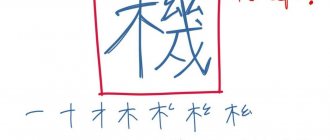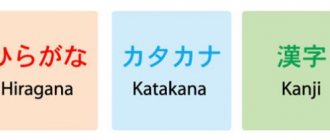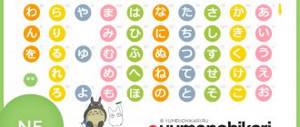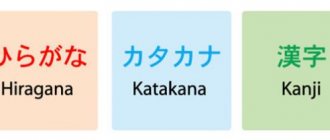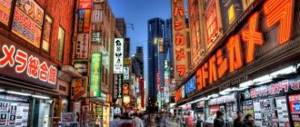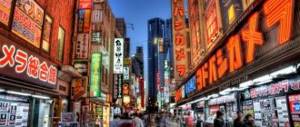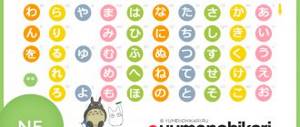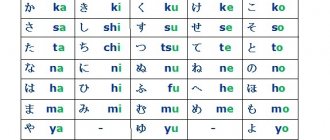The Japanese language has three writing systems. Two syllabary alphabet - hiragana and katakana - are used simultaneously with hieroglyphs, or kanji, which came to Japan from China. Let's figure out how hiragana and katakana sound in Russian, how they differ, look at tables with katakana and find out how best to learn it.
Japanese language: hiragana and katakana
The hiragana and katakana alphabets originated from hieroglyphs at the end of the 13th - beginning of the 9th century. Katakana alphabet
was invented by a Buddhist monk as a form of cursive writing. This was done so that people who do not know Chinese letters could read religious texts.
Its name literally translates to “broken kana” or “divided kanji”, which accurately conveys the story of its origin. After all, katakana characters are entire hieroglyphs in an unmodified form or their individual parts. Review the table below to learn how the Japanese alphabets were formed.
How the alphabet of Hiragana and Katakana was formed: table.
The Hiragana and Katakana alphabet contain a set of characters, each of which represents a different syllable . Despite the fact that both alphabets are phonetically the same, they are not at all similar in writing. Unlike the flowing hiragana with lots of curves and curls, katakana is full of angular letters and straight lines.
Many foreigners have a question: why do the Japanese need two identical-sounding alphabets? However, their main difference is in purpose . Thanks to this, while reading a text, a person can already say a lot about it, even without knowing the translation.
Japanese phonetics and pronunciation of some characters
1) Hiragana - syllabic alphabet
. The hiragana character is usually a syllable. The phonetic system of the Japanese language is based on a sequence of five syllables: A-I-U-E-O. At first glance at the table with hiragana, this principle will become clear to you.
2) う sign
pronounced like [u]. At the same time, when pronouncing, try not to round your lips too much. This way you will achieve a more correct sound.
3) し sign
.
Formally, this sound is often written in letters of the Russian alphabet as [si], according to the traditional system of recording Japanese words (according to the Polivanov system). BUT, this sign of the Japanese alphabet should be pronounced not as pure [si] or as they often incorrectly say [shi], but as an average between [si] and [shi]
. The correct pronunciation of the syllable し can be compared to the short sound “u” in the word “thing”. Be careful to learn how to pronounce this Hiragana sign correctly from the very beginning!
4) ち sign
. Despite the fact that in almost all textbooks for learning Japanese, this syllable is written as [ti], it is not pronounced that way. This is a formal notation (as is the case with し). The correct pronunciation of the sound is between [ti] and [chi]. Closer to short [chi], but not pure [ti].
5) ふ sign
pronounced [fu]. At the same time, when pronouncing, do not emphasize the initial [f], because it should be pronounced very lightly, barely noticeable. Try saying this syllable as if you were lightly blowing out a candle.
6) Signs of the series ら-り-る-れ-ろ
traditionally transcribed into Russian using the consonant sound [r]: ra-ri-ru-re-ro. It is important to pronounce the sound [r] briefly! The Japanese language does not have our “rolling” [r], when we can repeat endlessly: rrr... In fact, when you hear how native speakers themselves speak, you will understand that this consonant component in the series ら-り-る-れThe Japanese pronounce -ろ as something between l-r-d. This is such a difficult sound. Therefore, when you say - ra-ri-ru-re-ro - do not create a booming sound, but pronounce [r] in these syllables as briefly as possible.
7) Sign わ
pronounced [wa]. But try not to emphasize the initial “v” too much.
 Syllables containing the vowelえ [e]
Syllables containing the vowelえ [e]
: え、け、せ、て, etc. These syllables are traditionally written using the Russian letter “e”. Our “e” sound differs from Japanese in that in Japanese it is pronounced somewhat softer. Have fun spelling and remembering signs! See you at the next lesson!;-) Learn Japanese online with us! Test and consolidate your knowledge on our resource absolutely free!
Japanese language: katakana alphabet - rules of use
Despite its simple writing, katakana is the more difficult to remember . This is most likely due to its infrequent use. Katakana is the second alphabet, and the first and main alphabet is hiragana. When starting to learn a language, students first encounter it.
The first words and grammatical structures are written and memorized in hiragana, as it is used to indicate the auxiliary parts of words (endings, prepositions, postpositions). Katakana is usually used to write borrowed foreign words , or gairaigo. These include terms that come from Western languages, and borrowed words from Chinese or Korean are written in Kanji. For example:
- ケーキ (ke:ki) from the English “cake” (cake);
- アイスクリーム (aisukri:mu) from the word “ice-cream” (ice cream).
- コンクール (konku:ru) from the French “concours” (competition);
- ノルマ (noruma) from Russian "norm".
The long straight line that you see in the examples serves to indicate the length of the vowel sound.
The names of foreign cities , countries and Western names are exactly the same as gairaigo, so they are written in katakana.
But, in addition to the most common options listed, the Japanese katakana alphabet is found:
- When writing down words whose kanji have practically fallen out of use due to complex spelling. For example, バラ (bara) means “rose” and ゴミ (gomi) means “garbage”. These words also include medical terms . Thus, the disease “cancer” is often denoted by katakana rather than by the hieroglyph 癌.
- When you need to pay attention , focus on a certain word. This technique is often used in advertising, on billboards, road signs or signs. By comparison, in Western languages this is done using italics or bolding.
- When writing technical terms , names of machine , plants , animals , etc.. For example, クモ (kumo) - “spider”.
- In onomatopoeia, or words that convey sound . グーグー (gu:gu) means the sound made when snoring.
- In manga , when you need to emphasize communication in an informal style. For example, you can often see the word “he/she” written in katakana - アイツ (aitsu). This type of writing makes it clear to the reader that the address is most likely made in a disparaging manner.
It is recommended to start learning hieroglyphs last, when both syllabic alphabet are fully mastered. Kanji is an essential element of language, as it is used to write nouns, adjectives and verbs.
This contrast in the use of different writing systems allows you to visually highlight words in the text and recognize which parts of speech they belong to. Because of this, reading speed increases, making comprehension easier.
And to learn more about the two Japanese alphabets, read our article about their differences. It also has katakana and hiragana in tables with Russian transcription and useful tips on how to learn all their signs.
The problem of “identical” sounds. "R - L", "X - F"
The fact is that, due to the peculiarities of their language, the Japanese do not distinguish between some sounds that exist in other languages, but are absent in Japanese. For example, for them the combinations with: “b-v”, “ji-ji”, “schi-si”, “r-l”, “h-f”, etc. sound the same. Therefore, a special system of indications was developed in katakana when a sound is considered “x” and when “f”. Different spellings were established for groups of consonants “w” - “v”, etc.
In hiragana, such a system simply does not exist, because it is not needed to write Japanese words. In principle, you can find some of the above syllables (group “f”, “v”, etc.) written in hiragana according to the rules of katakana, but this is extremely illiterate. No Japanese would ever do that.
How to learn hiragana and katakana
There are many ways to remember all these Japanese characters. To get started, you can print out the hiragana and katakana alphabet in a table and hang it in a visible place on your desktop. Being always before your eyes, the letters will automatically be remembered.
Hiragana and katakana: table in Russian.
Even though people write by hand less and less these days, you will need to use cursive writing . When writing syllables, muscle memory is activated and they are remembered faster.
We must remember that the order in which the strokes are written is very important. It greatly simplifies life, because the writing skill becomes automatic, which helps with memorization.
You can start with copybooks for beginners. They do not have voiced or compound syllables, but if you remember the spelling of the basic combinations, you will not have any difficulties with the rest. Then you can move on to more complex katakana writing.
Although katakana is easier to write, it is quickly forgotten. To avoid this, it is recommended to practice writing these two alphabets in parallel. This will help you avoid confusion between them in the future. Practice sheets can be found below.
Hiragana and katakana - copybooks:
- Hiragana alphabet;
- katakana alphabet.
And if you have not yet learned enough about the rules of writing hiragana, we recommend that you read our article on Japanese writing. In it you will also find hiragana and katakana copybooks, which can be downloaded in PDF format.
Another way to learn a language is through mnemonics . If you just try to memorize a word, you will forget it in a few days. Therefore, it is better to use special associative techniques to remember new words or symbols. All three writing systems—kanji, katakana, and hiragana—are best taught using this method.
You can also use cards : write the letter on one side and the translation on the other. But no more cutting them out of cardboard, because Quizlet lets you create them online. There you will also find already created training materials. For example, mnemonic cards for hiragana and katakana for beginners.
Katakana: learn with mnemonics.
Another fun way to learn these ABCs is to learn a nursery rhyme. They are very presentable, so you still have to try to forget her.
Now you know what the Japanese katakana alphabet sounds like with a translation into Russian and where it is used. Katakana is no less important aspect of the language than its sister alphabet. With its help, the text places emphasis on individual words, giving them a special shade.
What do you like best: Japanese katakana and hiragana or kanji? Write in the comments!
Japanese katakana alphabet: table, pronunciation and writing. The most important thing you need to know about katakana! Learn katakana tables in Russian and methods of memorizing them.
Links
https://www.komi.com/Japanese/ - “Japanese Language Self-Teacher”, online Japanese language training, lessons, many examples and other necessary information
https://www.rinet.ru/~vit/ - “Page of Vitaly Zagrebelny”, an excellent Russian source, many links to a variety of useful resources on the language, FAQ
https://www.csse.monash.edu.au/~jwb/japanese.htm - “Jim Breen's Page”, various projects, many programs, many links on teaching katakana, hiragana and kanji, dictionary projects, etc. , links to literature in Japanese (for practice in the language), grammar, spelling, Japanese tutorials
Hieroglyphs and their pronunciation
Katakana, like the Japanese syllabary, fully complies with all the canons of kana. It contains exclusively vowel sounds and consonant combinations, followed by open vowels. Very rarely there are nasal sonants, which are predominantly softly pronounced. There are few characters in the alphabet: nine vowels, 36 open moras (syllables) and one nasal 'n, which is indicated by the sign ン. It is also important to note that in katakana all hieroglyphs have precise and strict outlines. Their lines are straight, the endings are clear, the intersections are always made in the same places.
Origin of writing
The Japanese alphabet Hiragana was born around the 5th century. Man'yegana is considered her ancestor. This compound word refers to the writing system that was in use in Japan before the advent of hiragana. With its help, hieroglyphs were written down that sounded approximately the same as Chinese, but were written completely differently. In fairness, it is worth noting that later, when Man'yegan was transformed, the influence of the Chinese language on it became even greater. Hiragana originated from writing these ancient characters in the Caoshu style of Chinese calligraphy. This metamorphosis forced many written signs to change their forms beyond recognition. And perhaps only a professional for whom Japanese is a native language can find similarities between the ancient language and the modern writing system.
Pronunciation of grammatical connectives
This item is just information for your information. You will learn more about everything that is stated here if you learn Japanese.
is a special grammatical symbol, it is also considered part of hiragana. In its pronunciation it differs little from the sound “o”. Used only in certain grammatical constructions and never to indicate a sound as part of a simple word.
Some hiragana syllables are used as grammatical connectives in Japanese. In this case, they have something else
pronunciation different from that recorded in the text above. These are the syllables “ha / ha” and “he / he”. If you learn Japanese, you will learn more about this.
Description of katakana
This writing system cannot exist independently, at least not in modern Japanese. The Japanese alphabet katakana is used to describe phenomena, objects or names that are of foreign, including Russian or European origin. Also, hieroglyphs of this group are often found in paintings, poetry and prose. This is necessary in order to give the work a special, unique color. Also, katakana very often comes across our eyes in people’s correspondence, in their colloquial speech (mainly in the regions of Japan), in foreign posters and slogans.
Pronunciation of “long” vowels
Hiragana has its own system for recording “long” sounds, different from katakana. So, let's start in order:
Case 1
- when any syllable is pronounced for a long time, except for the vowel “o” and syllables of the form “consonant + o”, then after this syllable a hiragana “o” is added. Example:
Case 2
- when the vowel “o” or any syllable of the form “consonant + o” is pronounced for a long time, then after this syllable the hiragana “u/u” is added, and not the hiragana “o”. That is, two “o” sounds cannot appear in a row. Example:
Case 3
- when you do see two consecutive vowels “o” in the text, or a construction like “consonant + o” + “vowel o”, then do not be surprised. This means that in this word there is no lengthening of the sound, but the same sound is pronounced twice in a row. To differentiate their spelling from long sounds, I will separate the two parts of the vowel with a dash. Example:
Note 1:
all three of the above rules also apply to the derivative vowel “е”, as well as to derived syllables with the vowel “е”. (Read below for what derivative syllables are.) Here is an example:
Note 2:
It is quite difficult for a Russian person to distinguish by ear when a Japanese word has a long vowel and when a double vowel is pronounced. This is due to the fact that the Japanese pronounce them in one exhalation without a pause. So the Japanese double vowel in its pronunciation is almost no different from the Russian long vowel, and the Japanese long vowel is an ordinary (only slightly drawn out) vowel of the Russian language. Therefore, in the kiriji recording system, the longitude of sounds is extremely rarely noted. Most often, when transcribing a word from Hiragana to Kiriji, it is written down as more familiar to the Russian ear, unless this distorts its pronunciation. For example, not “arigatoo”, but “arigato”.
